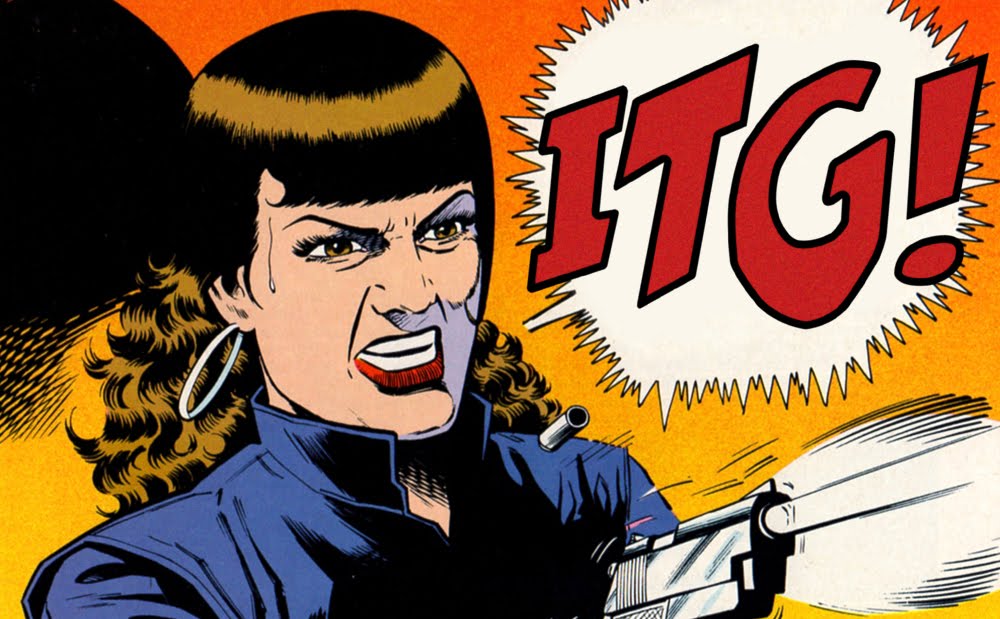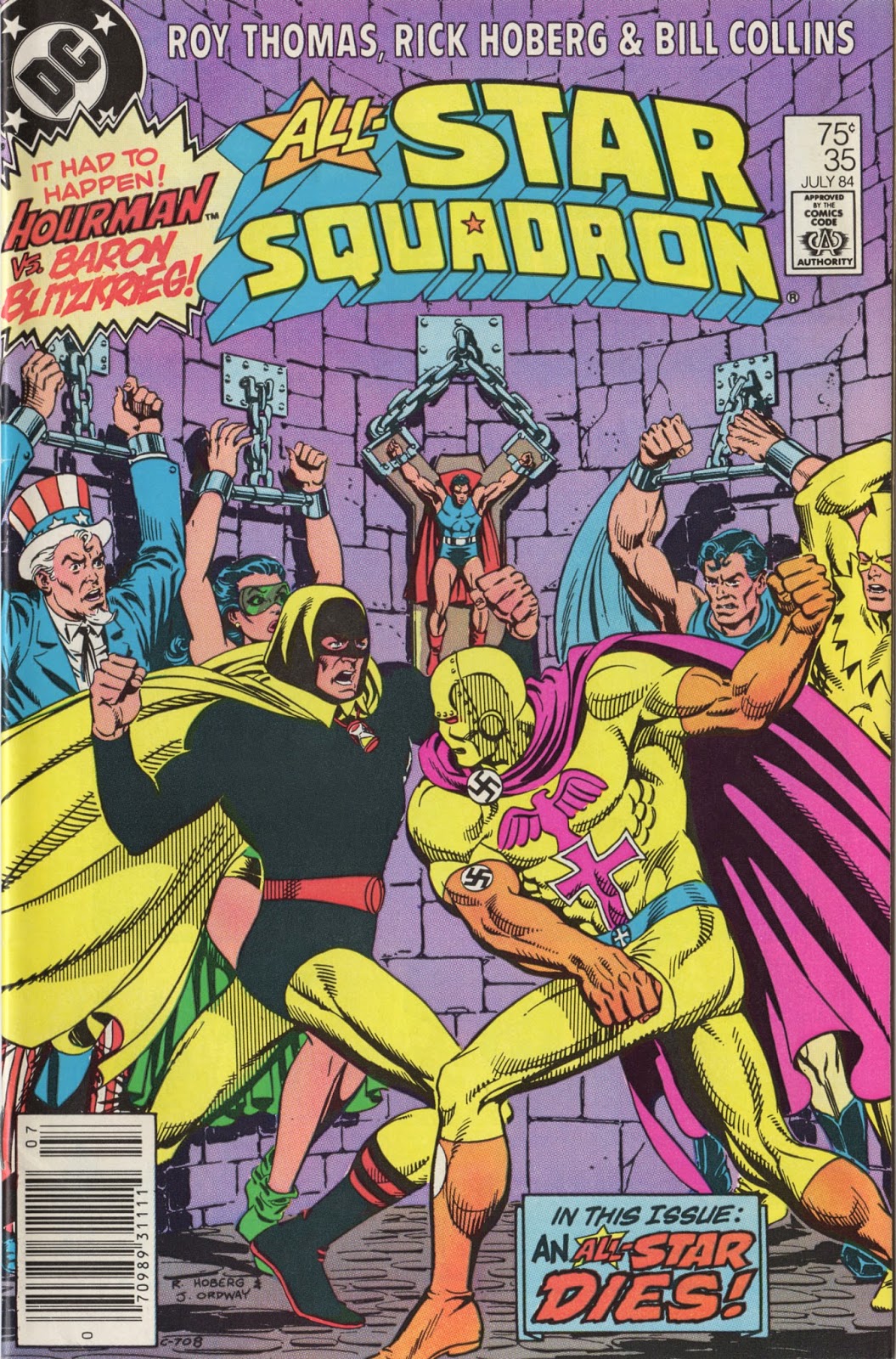So - the last Balloon Buster story.
Writer James Robinson took the reigns of the Balloon Buster legend 15 years after Robert Kanigher's last BB story, and in one full issue, plus hints dropped in various others, made sweeping changes to Steve Savage's history - and in the process, and with help from 2 excellent artists, produced what might be the best ever Balloon Buster story.
Spinning out the 1994 crossover event
Zero Hour (which made some loosey-goosey, but mostly minor changes to the timeline established in
Crisis on Infinite Earths), James Robinson's title
Starman, besides being an excellent title in its own right, did something very important - it made the idea of
legacy important. In the time between the
Crisis (which while celebrating the long history of DC Comics, kind of closed the book on many of its characters) and
Starman, DC Comics seemed to try to forget its history and classic characters. The Justice Society of America, DC's 1st superteam, comprised of such golden greats as Hourman, Starman, original incarnations of The Flash, Green Lantern & Hawkman among others, was shuffled off to an alternate dimension, then eventually brought back only to have 1/2 the team murdered. This treatment of its past by DC Comics was entirely disrespectful, perhaps, in the eyes of James Robinson, as he used
Starman to celebrate not only the golden age of heroes, but many aspects of DC's long history.
 |
| 1 panel appearance, revealing Steve Savage as Son of Scalphunter - from Starman Annual #2 (1997) |
The lead character of
Starman, Jack Knight, is the son of Ted Knight, the very 1st hero to go by the name of Starman. The series follows Jack's struggle to come to grips with his father's legacy and his effort to become his own man - his own kind of hero. Along the way, Jack stumbles upon the legacies of all the heroes throughout the history of DC Comics that used the Starman name, which (though seemingly preposterous to think there could be any relation at all between the Golden Age hero & the mystery man from the 50s, the Starmen from space & even Star Boy from the 31st century Legion of Super-Heroes) James Robinson ties together with skill & artfulness.
Equally preposterous is that Robinson applies this affect to Steve Savage, The Balloon Buster. The name Savage is used to link 3 separate and previously unrelated DC Comics features. Robinson (in various issues of
Starman, but finally illustrated in
Starman Annual #2) proposes that the man who raised the young Savage and taught him to 'be the GUN!' was not his father - Steve Savage was the son of Brian Savage, the former Old West vigilante,
Scalphunter. After Brian Savage's scalphuntin' days were over, he became sheriff of Opal City (Robinson's fictional city in the tradition of Metropolis, Gotham, Central City, etc., and longtime home of the Starman line), and was eventually shot & killed. A family friend, possibly a relative, took in the infant Steve Savage, and the story could resume as told in Steve's 1st appearance in
All-American Men of War #112. It is also suggested that Brian Savage was the son of an even earlier Western hero, Matt Savage, Trail Boss, so Steve Savage was the inheritor of a newly fabricated heroic legacy, courtesy of James Robinson.
 |
| Batman v. a faux-Balloon Buster |
 |
| Final fate of Steve Savage - as related by Batman's thought balloons |
Steve Savage, and his connection to Opal City via his father, found their way into
Batman: Legends of the Dark Knight Annual #7, written by Robinson and illustrated by Steve Yeowell & Balloon Buster original artist, RUSS HEATH! In this issue, Batman becomes embroiled in a mystery: a man is murdered by an assailant masquerading in the garb of legendary WWI pilot Steve Savage, The Balloon Buster. The killer is apparently after a treasure Savage brought home from the war (it's here established that Savage must have survived his wounds at the hands of The Enemy Ace in his
last story appearance 15 years prior). During his investigation, Batman comes across newspaper articles detailing Savage's post-War existence - gained mild fame stunt flying, opened his own airfield (since named Savage Field), and a finally,
mysteriously disappears over the Opal City skies - Savage took to the air one last time in an effort to confront a rumored dragon who may have been the cause of a fever epidemic (
one gripe - all of this begs to be depicted on the comics page, as opposed to being read in Batman's thought bubbles sitting in a local library). Batman takes the time to read a chapter in a rare published biography of Steve Savage, called
I Am a Gun, and this sequence - detailing Savage's last days in the War - are illustrated by none other than original Balloon Buster artist - Russ Heath! What a coup! This is Heath's first work on the character in over 30 years, and it is excellent! At this point in his career, Russ Heath was still drawing the best aircraft in the business, and the action in this flashback sequence is wild!
 |
| Steve Savage - inheritor of a grape - I mean GREAT - family tradition |
In the waning days of WWI, and on the verge of being tamed by French farm girl, Rochelle, the one true love of his life, Savage is a little surprised by the quick acceptance by his betrothed's vintner father. While bestowing his approval on the imminent union, he passes on to Savage the 'family treasure' (which in the present has been the impetus of a string of murders). Returning from his next flying mission, Savage finds that a rogue squadron of retreating Germans has raided the nearby town, and his fiance and her entire family have been brutally killed. Fueled by rage, Savage, in his yellow Spad, hunts down the fleeing band and in a magnificent action sequence manages to kill each and every one. The centerpiece of this issue, the Heath illustrated flashback is sad & brutal, but so well executed and really shines an unprecedented light on the character of Steve Savage.


In the present, Batman finally confronts the Balloon Buster-look-alike killer and is forced into an aerial chase in which Bats pulls some Steve Savage-esque stunts such as jumping from one biplane to another to rescue a hostage, then jumping BACK to his own plane in time to make a safe landing. WOW!
 |
| Batman reads through Steve Savage's life story - a minor gripe: Bruce has it wrong - the battles between Hans Von Hammer & Steve Savage were very much conclusive, decidedly in VON HAMMER'S favor. To Steve Savage's credit, however, to take on The Enemy Ace on more than one occasion & SURVIVE - this is no mean feat! |
 |
| Imitation is the sincerest form of flattery - Batman performs a Steve Savage-esque stunt by jumping from one biplane to another (with a hostage in tow!). |
With the killer brought to justice, the mystery of Steve Savage's treasure remains: it's soon discovered that the inheritance brought home from Europe and war was - a grape vine. Savage's near in-laws were, remember, farmers and vintners. Though it was too personal a venture to attempt to grow the grapes and make the wine himself, Savage was still determined to extend the legacy of Rochelle and her family in the U.S. The plant apparently took to Savage's home soil, and its descendents were still producing wine. The story ends with a rare depiction of The Batman imbibing, as he raises a glass of red to a portrait of The Balloon Buster.
 |
| Pouring one out for The Balloon Buster |
And the story really
was over for Steve Savage - though it was nice to see it end on such an incredibly high note. Savage was given a noble, ambiguous ending (not a million miles away from the one given by his creator, Bob Kanigher), and was reunited with his original artist. I'm so glad that James Robinson dug up this obscure character, and was able to breath new life into it, and also in a small way through Scalphunter, and the world of Opal City, connecting Steve Savage to the larger DCU. This connection also reinforced the character's original conception - having one foot in the Western comics tradition and the other in war comics.
With this issue re-cap, the initial mandate for this blog has been fulfilled. I've loved looking back at these obscure and mostly uncollected Balloon Buster stories, and hope to have posts on topics I love equally - sometime soon.
For the time being, I'm contemplating a tropical vacation in an alternate universe . . .


































